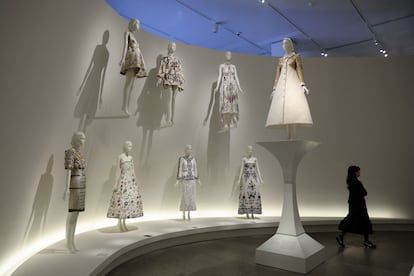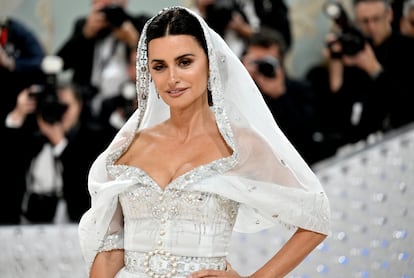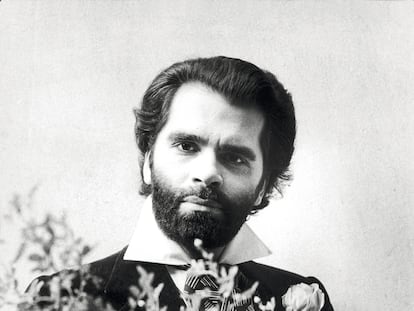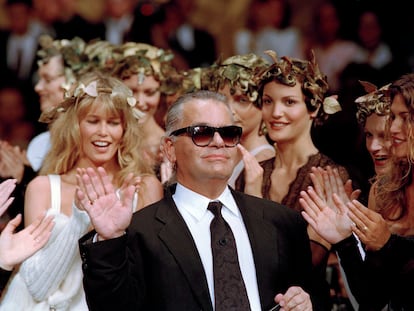Met Fashion Gala revives Karl Lagerfeld’s legacy
The exhibition that the Metropolitan Museum of Art in New York is dedicating to the German designer until mid-July shows 200 outfits from a production of 10,000 over six decades


Unlike in previous years, the main attraction of the Met Gala 2023 has not been a brand, an era or a concept, but a person: Karl Lagerfeld. The designer, who died in 2019 at the age of 85, was known as much for his sketches for Chanel, Fendi, Chloé and his own brand as for his character: skinny pants with frock coats, black glasses, embroidered mittens, ponytail and his inseparable Choupette, “the Garbo of cats” in his words, the kitten to whom he bequeathed part of his fortune. The man who “in the world of the ephemeral was someone permanent”, as the former model Carla Bruni defined him on Monday in New York; the man “interested in everything except mediocrity” reaches the halo of immortality in an exhibition that brings together nearly 200 pieces, selected from more than 10,000: the production of a career that lasted six decades. The gala, with its galactic catwalk of celebrities, was as usual a display of fireworks -as well as a fundraising event, its main purpose-, while the Metropolitan Museum’s exhibition, which will open to the public on Friday until July 16, provides a silent encounter with the essence of the genius.
The exhibition, which was presented on Monday in New York hours before the gala, is entitled Karl Lagerfeld: A Line of Beauty, in allusion to the serpentine line, or line of beauty, theorized in the eighteenth century by the British artist William Hogarth: a curved line in the form of that which appears within an object or as a boundary line of it, and that represents the liveliness and movement. The rooms that house, thematically, the production of the Kaiser of fashion meander like gigantic eses through a sinuous structure designed by Tadao Ando. The pieces on display traverse from his beginnings as an assistant designer at Balmain and artistic director of Patou to the outfits that shaped his final collection, in 2019. Curated by Andrew Bolton, the world’s most influential fashion curator, the show is both a thematic and conceptual essay, with multiple approaches paired in contrasts: the masculine and the feminine, the romantic and the military, the historical and the futuristic....

Anna Wintour, the editor-in-chief of Vogue, hostess and organizer of the gala and the exhibition for two decades, was a close friend of the German and often recalls that all the important moments of her life were dressed by one of his designs. This friendship, the proximity of the artist to the Monaco royal family or the ring of top models that always surrounded him protected him from controversy, embodied in racist, xenophobic, homophobic comments, against fat women or gay marriage. Lagerfeld publicly criticized MeToo, Germany’s openness to refugees by Chancellor Angela Merkel - including an unfortunate reference to the Holocaust -, the singer Adele for her measurements, and those who denounced, not without reason, the unhealthy image of many models at the limit of their weight. “Nobody wants to see” plus-size models; “You’ve got fat mothers with their bags of chips sitting in front of the television and saying that thin models are ugly,” he ironized in 2009 in an interview to a German magazine.
A wizard of couture, but also cruel and cutting, someone who “offended people left and right” during his life, as Vanessa Friedman, fashion editor of the New York Times, wrote after his death, the German emerges unscathed in the Met exhibition, without any reference to his mishaps, which were not far from those that cost John Galliano his career. There is no room in the exhibition for criticism, only praise. “Karl Lagerfeld was one of the most captivating, prolific and recognizable forces in fashion and culture, known as much for his extraordinary designs and tireless creative output as for his legendary personality,” says Max Hollein, the museum’s director. Hollein admits, however, his provocative disposition. “He certainly provoked with his statements, but I think it’s important to see the exhibition as a celebration of his art, of his creative expression, and also as an analysis of his public persona. On the one hand, there is a separation between artistic production and what one does personally. But on the other hand, we also reflect on his personality,” he said Monday.

Multifaceted (he was also a photographer, writer, editor and interior designer), Lagerfeld was in his own way a precursor of young talents who revolutionized the essence of fashion, such as the late Virgil Abloh. The temporal dimension of the phenomenon of fashion, far from underlining its ephemeral nature, is rooted in the obligatory permanence of a museum. There is no room for contradictions, Hollein argues; the mutable and inconstant expression of fashion fits in a museum, and vice versa. The museum director reminded those present during the presentation that the Met was founded over 150 years ago, basically to inform the artisans of New York about how to make better art, better fabrics and better costumes. So, fashion is very much in tune with its identity, and dedicating a part of the museum to fashion every year is, in his view, a manifestation of creativity, of artistic excellence, of the ability to capture the contemporary spirit and give it a fantastic three-dimensional form. In reality, he concluded, fashion is an art that has been around for many centuries.
The Super Bowl of global fashion
The Met Gala exhibition attracts hundreds of thousands of visitors each year; the 2018 exhibition, for example, devoted to the influence of Catholic imagery on design, was the museum’s most-viewed that year. The gala has a planetary, almost galactic audience. But Hollein is not afraid of the shadow cast over the museum by this global catwalk show, often called the Super Bowl of fashion, and rivaling the Oscars themselves in audiovisual reach. He even acknowledges that it adds to the Met’s profile, prominence and understanding, recalling that when he was appointed director of the museum five years ago, the one thing that excited his children, and all their friends, was that he would be attending the gala.
But in addition to a carpet, not always red, but certainly always global, the gala is a giant cash register that serves to finance the activities of the institution’s Costume Institute. Last year it raised $17.4 million (the museum’s spring gala made only $2.6 million). An individual ticket is priced at $50,000; a full table for dinner, which is often booked by companies, starts at $300,000. But it is not only necessary to be rich to access the sancta sanctorum of glamour, through the steps of the Fifth Avenue of the centenary building: you have to be famous, relevant or an influencer. And you also have to be summoned, it is not enough to self-invite oneself, checkbook in hand.

Alongside Wintour, four co-hosts presided over the event. In addition to tennis player Roger Federer, a friend of the Vogue editor, the spotlight was fully focused on Penélope Cruz, Chanel’s long-time ambassador, and singer Dua Lipa, who wore a wedding dress from Lagerfeld’s 1992 collection for the Maison. Cruz shone in a white gown embroidered in silver with a cape. As co-hostesses, they were the first to arrive, together, alongside Wintour, in a Chanel from the latest collection and next to the always elegant British actor Bill Nighy. Also co-chairing the gala was screenwriter, actress and producer Michaela Coel, who was on the cover of Vogue last year, in a loop of media representation that feeds back relentlessly. The attire of the nearly 400 guests abounded in virginal white and pure black, in the essential monochromatic line of the Kaiser, with few touches of color, such as Salma Hayek’s blood-red dress or the occasional daring yellow.
Last year 275,000 pink roses adorned the lobby of the museum, which a giant tent hid from the gaze of the curious on Monday. A single detail of the excess that underlines the renewed bet to stun even more than the previous one, in decoration, in convening power, in costumes. As if the theme of the circus, the most difficult yet, was transformed into the most impossibly glamorous gala, to feed and renew a spectacle that is self-absorbed. That is why the Met Gala, whose origins date back to 1948 as a dinner for New York’s high society, has metamorphosed over time into a platform for the exhibition of influencers, celebrities, celebrities and the occasional royal. The arrival of the guests was streamed on social media accounts. And the list of the lucky diners, revealed after an almost summary secret until the last second to increase interest, showed that the succession of epiphanies lasted much less than the expectation aroused.
Sign up for our weekly newsletter to get more English-language news coverage from EL PAÍS USA Edition
Tu suscripción se está usando en otro dispositivo
¿Quieres añadir otro usuario a tu suscripción?
Si continúas leyendo en este dispositivo, no se podrá leer en el otro.
FlechaTu suscripción se está usando en otro dispositivo y solo puedes acceder a EL PAÍS desde un dispositivo a la vez.
Si quieres compartir tu cuenta, cambia tu suscripción a la modalidad Premium, así podrás añadir otro usuario. Cada uno accederá con su propia cuenta de email, lo que os permitirá personalizar vuestra experiencia en EL PAÍS.
¿Tienes una suscripción de empresa? Accede aquí para contratar más cuentas.
En el caso de no saber quién está usando tu cuenta, te recomendamos cambiar tu contraseña aquí.
Si decides continuar compartiendo tu cuenta, este mensaje se mostrará en tu dispositivo y en el de la otra persona que está usando tu cuenta de forma indefinida, afectando a tu experiencia de lectura. Puedes consultar aquí los términos y condiciones de la suscripción digital.
More information
Archived In
Últimas noticias
There is as much life left to discover on planet Earth as that which is already known
Dozens presumed dead, around 100 injured in fire at Swiss Alps bar during New Year’s celebration
Is porn for women different from conventional porn? We spoke to those who make it
Cartagena de Indias is sinking: What can the city do to mitigate it?
Most viewed
- Reinhard Genzel, Nobel laureate in physics: ‘One-minute videos will never give you the truth’
- Sinaloa Cartel war is taking its toll on Los Chapitos
- David King, chemist: ‘There are scientists studying how to cool the planet; nobody should stop these experiments from happening’
- Oona Chaplin: ‘I told James Cameron that I was living in a treehouse and starting a permaculture project with a friend’
- The Interoceanic Train, the Mexican alternative to the Panama Canal










































